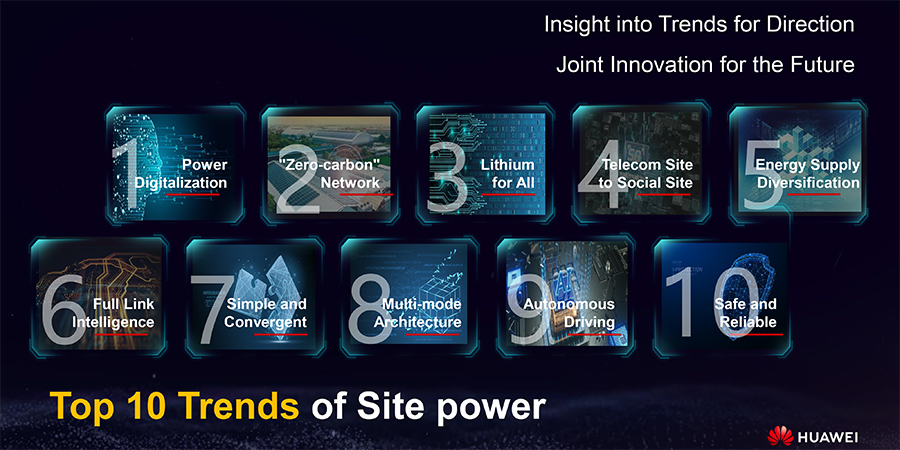By Libo, VP of Site Power Section, Huawei Digital Power Middle East
As emerging technologies such as 5G, Internet of Things (IoT), cloud computing, and artificial intelligence (AI) are rapidly commercialized, the digital transformation in various industries is prospering. The epidemic and carbon neutrality goals further accelerate the transformation towards a smart society. Combination with the power electronics technologies and digital technologies brings site power new trends.
Power digitalization
The full power link from power generation, conversion, storage, to use will be digitalized, making energy networks visible, manageable, controllable, and optimizable. Energy network will change from the traditional watt flow to watt+bit collaboration, driving the digital transformation of site power from points, chains, and networks with the concept of Bit Manage Watt.
"Zero-carbon" network
In the future, the full link of power generation, load consumption, and power conversion and storage will be green, efficient, and energy-saving. From the top-level network planning and design, construction and capacity expansion, to the reconstruction and optimization, digital O&M and energy efficiency management, and zero-carbon evaluation, a zero-carbon network will be realized through the integration of power electronics, digital, and AI technologies.
Lithium storage everywhere
Thanks to its long lifespan and continuous technology development, lithium batteries gradually replace lead-acid batteries in large-scale application. With combination of power electronics and digital technologies, the local BMS and cloud BMS will collaborate with each other and lithium batteries will become intelligent and cloud-based. Lithium batteries will be safer, applicable to more scenarios, and with more efficient O&M, maximizing the value of site energy storage.
From telecom site to social site
With 5G commercial use, a large number of digital sites are emerging. Varied scenarios require more flexible and diversified sites. Traditional sites with the single function of communication connection will evolve to social sites with comprehensive functions, maximizing the site value.
Energy supply diversification
The diversification of energy supply is embodied in three aspects: First, solar energy will gradually shift from supplementary to primary. Second, site power will change to ICT converged power supply and begins to power people's livelihood and production. Third, the diversification of deployment modes, such as centralized solar power plant, household PV power supply.
Full link intelligence
Traditional siloed architecture and isolated management of energy subsystems will evolve towards integrated smart energy. The software-defined subsystems for power generation, conversion, storage, distribution, consumption, and temperature control will use AI algorithms to achieve full-link collaboration and optimal power supply systems.
Simple and convergent
Sites will evolve from equipment rooms to cabinets and poles, reducing the footprint and power consumption. The site power efficiency will be further improved and the electricity fee will also decrease, achieving low carbon emission throughout the entire network and realizing simplified power supply during the lifecycle.
Multi-mode architecture
Site power will develop towards a multi-mode coordinated architecture-supporting multiple energy input and output modes, multi-mode scheduling control and management. One modular power supply system applies to multiple scenarios and realizes converged power supply for different services and devices.
Autonomous driving
Autonomous driving is the development theme of site power in the future. AI technologies will simplify energy O&M, implement remote O&M, self-learning, and automatic O&M, and improve O&M quality and efficiency. The intelligent IoT connection technologies and intelligent sensing technologies will enable digital management. With digital sensors and the intelligent management platform, all components and devices in the energy network can be sensed and interconnected.
Safe and reliable
The reliability, security, privacy, and resilience of hardware and software become necessary requirements. Predictive maintenance at the hardware side, and layered control and defense functions at software side, makes the energy industry more safe and reliable.
Deep insights into the industry trends help better adapting to future challenges. Huawei aim to work with industry customers, partners, and third-party organizations to promote innovations and achieve win-win outcomes in the digital power era.
For more information of site power facility, please visit huawei website










